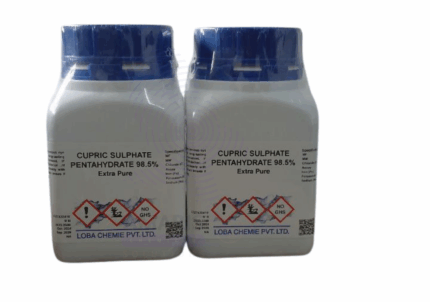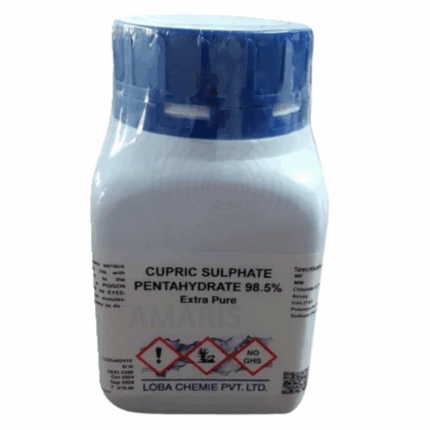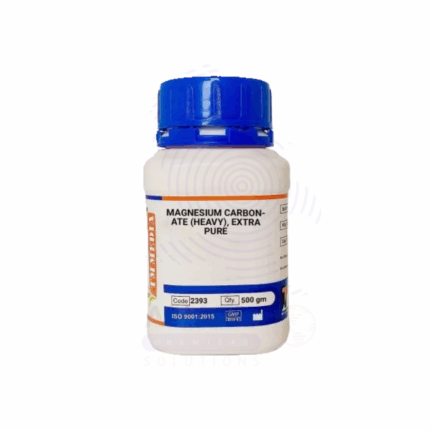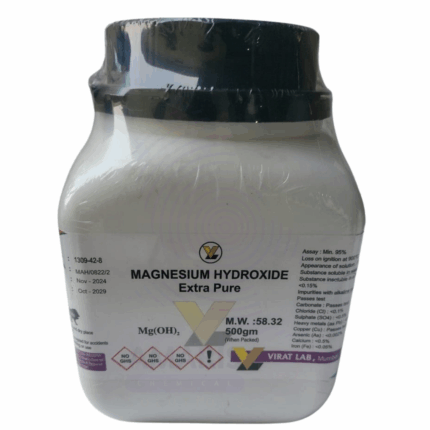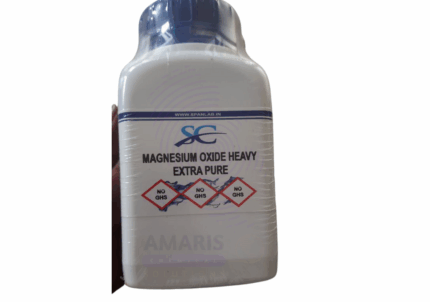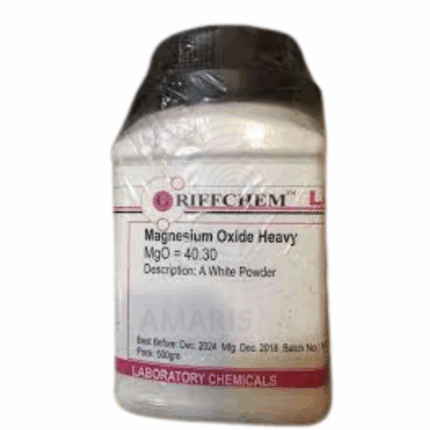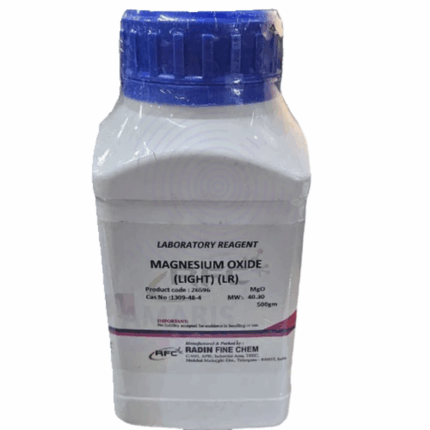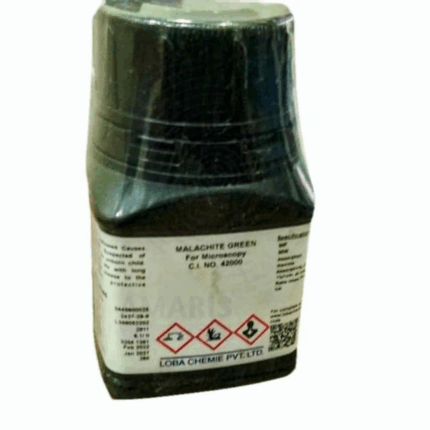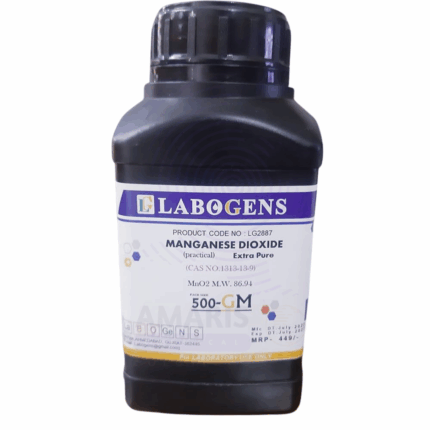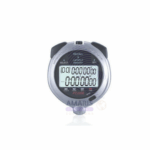
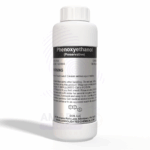
Phenolphthalein Powder Extra Pure
$ 19.10 Original price was: $ 19.10.$ 18.98Current price is: $ 18.98.
Phenolphthalein Powder Extra Pure is a high-purity pH indicator extensively used in analytical chemistry and laboratory applications. This fine, white to pale pink crystalline powder is colorless in acidic solutions but turns a vivid pink to deep magenta in basic environments, typically transitioning around a pH of 8.2 to 10.0. Its sharp and distinct color change makes it ideal for acid-base titrations, particularly in educational, industrial, and research settings.
In addition to its primary role in titrations, Phenolphthalein is also used in various chemical formulations, soil pH testing, and sometimes as a dye component in forensic applications. Although previously used as a laxative, it is now restricted to laboratory use due to health concerns. It should be handled with care—using gloves, protective eyewear, and in well-ventilated areas—to avoid inhalation or prolonged contact. Store in a cool, dry place, away from strong oxidizers and light.
Phenolphthalein Powder Extra Pure
PRIMARY USES
- Acts as a pH indicator in acid-base titrations, changing from colorless (acidic) to pink (alkaline) around pH 8.2–10.0.
- Commonly used in analytical chemistry for titration of weak acids with strong bases.
- Utilized in laboratory experiments for teaching acid-base concepts in educational settings.
- Key ingredient in formulating chemical test kits and indicator solutions.
- Sometimes included in water quality testing to assess alkalinity levels.
SECONDARY USES
- Historically used as a laxative component (now largely discontinued due to safety concerns).
- Employed in forensic science in presumptive blood tests like the Kastle-Meyer test.
- Occasionally used as a colorant in pH-sensitive applications.
- Studied in chemical kinetics and reaction mechanisms as a visual reaction marker.
- Can be used in environmental monitoring to measure pH in soil and aquatic systems.
1. Basic Identification Attributes
- Chemical Name: Phenolphthalein
- CAS Number: 77-09-8
- HS Code: 2932.29.90
- Molecular Formula: C₂₀H₁₄O₄
- Synonyms:
- 3,3-Bis(4-hydroxyphenyl)-1(3H)-isobenzofuranone
- C.I. 764
- Phph
- Indicator B
2. Physical & Chemical Properties
- Physical State: Solid (fine crystalline powder)
- Color & Odor: White to pale yellow; odorless
- Boiling Point: Decomposes before boiling
- Melting Point: ~258–262 °C
- Density: ~1.3 g/cm³
- Solubility:
- Insoluble in water
- Soluble in alcohol and alkaline solutions
- pH Level (Indicator Range):
- Colorless below pH 8.2
- Pink to fuchsia above pH 10.0
- Vapor Pressure: Negligible
- Flash Point: Not applicable
- Autoignition Temperature: Not readily available
- Viscosity: Not applicable
3. Safety & Hazard Attributes
- Hazard Class (GHS Classification):
- Health Hazard (Carcinogenic - suspected)
- Irritant (may cause eye, skin, and respiratory tract irritation)
- NFPA Ratings:
- Health: 2
- Flammability: 1
- Reactivity: 0
- Exposure Limits:
- OSHA PEL: Not established
- ACGIH TLV: Not established
- Reactivity:
- Stable under recommended conditions
- Avoid strong oxidizing agents
4. Storage & Handling Attributes
- Storage Conditions:
- Store in tightly sealed containers in a cool, dry, and well-ventilated area
- Protect from moisture and light
- Incompatible Materials:
- Strong acids and oxidizers
- Container Type: Plastic or glass containers with tight seals
- Shelf Life & Expiration Date: Up to 3 years if stored properly
- Special Handling Requirements:
- Use gloves, safety goggles, and a dust mask or fume hood when handling powder
5. Regulatory & Compliance Attributes
- Regulatory Status:
- Listed in TSCA, REACH
- May be subject to reporting under SARA Title III
- Transportation Restrictions:
- Not classified as a hazardous material for transport (non-DOT regulated)
- Waste Disposal Method:
- Dispose via licensed chemical waste handler according to local regulations
6. Environmental & Health Impact
- Ecotoxicity:
- Toxic to aquatic organisms in large quantities
- Persistence in Environment:
- Moderately persistent under natural conditions
- Carcinogenicity/Mutagenicity:
- IARC: Group 2B (possibly carcinogenic to humans)
- OSHA: Recognized as a potential occupational hazard
- Biodegradability:
- Limited; may degrade slowly in soil or water
SAFETY PRECAUTIONS
Personal Protective Equipment (PPE):
- Wear a lab coat, nitrile gloves, and chemical splash goggles.
- Use a dust mask or work in a fume hood to avoid inhalation of fine particles.
Handling:
- Avoid contact with eyes, skin, and clothing.
- Prevent dust generation and inhalation.
- Wash hands thoroughly after handling.
- Use only with adequate ventilation.
Storage:
- Store in a cool, dry, and well-ventilated area.
- Keep the container tightly closed.
- Protect from moisture and light.
- Store away from strong oxidizing agents and acids.
FIRST AID MEASURES
Inhalation:
- Move to fresh air immediately.
- Seek medical attention if respiratory symptoms develop.
Skin Contact:
- Wash thoroughly with soap and water.
- Remove contaminated clothing.
- Seek medical advice if irritation or redness occurs.
Eye Contact:
- Rinse cautiously with water for several minutes.
- Remove contact lenses if present and easy to do.
- Continue rinsing and seek medical attention.
Ingestion:
- Rinse your mouth thoroughly with water.
- Do not induce vomiting.
- Seek immediate medical attention.
FIRE FIGHTING MEASURES
Flammability:
- May be combustible in powder form. Fine dust can pose explosion hazard in air.
Extinguishing Media:
- Use dry chemical, carbon dioxide, or alcohol-resistant foam.
- Water spray may be used to cool containers but can spread dust.
Hazardous Combustion Products:
- May produce carbon oxides and toxic fumes upon decomposition.
Firefighter Protection:
- Wear self-contained breathing apparatus (SCBA) and full protective clothing.
- Avoid inhalation of combustion products.


 Preservatives(food)
Preservatives(food) Flavor Enhancers
Flavor Enhancers Acidulants
Acidulants Sweeteners
Sweeteners Antioxidants
Antioxidants Colorants(food)
Colorants(food) Nutraceutical Ingredients (food)
Nutraceutical Ingredients (food) Nutrient Supplements
Nutrient Supplements Emulsifiers
Emulsifiers
 Collectors
Collectors Dust Suppressants
Dust Suppressants Explosives and Blasting Agents
Explosives and Blasting Agents Flocculants and Coagulants
Flocculants and Coagulants Frothers
Frothers Leaching Agents
Leaching Agents pH Modifiers
pH Modifiers Precious Metal Extraction Agents
Precious Metal Extraction Agents
 Antioxidants(plastic)
Antioxidants(plastic) Colorants (Pigments, Dyes)
Colorants (Pigments, Dyes) Fillers and Reinforcements
Fillers and Reinforcements Flame Retardants
Flame Retardants Monomers
Monomers Plasticizers
Plasticizers Polymerization Initiators
Polymerization Initiators Stabilizers (UV, Heat)
Stabilizers (UV, Heat)
 Antifoaming Agents
Antifoaming Agents Chelating Agents
Chelating Agents Coagulants and Flocculants
Coagulants and Flocculants Corrosion Inhibitors
Corrosion Inhibitors Disinfectants and Biocides
Disinfectants and Biocides Oxidizing Agents
Oxidizing Agents pH Adjusters
pH Adjusters Scale Inhibitors( water)
Scale Inhibitors( water)
 Antioxidants(cosmetic)
Antioxidants(cosmetic) Emollients
Emollients Fragrances and Essential Oils
Fragrances and Essential Oils Humectants
Humectants Preservatives
Preservatives Surfactants(cosmetic)
Surfactants(cosmetic) Thickeners
Thickeners UV Filters
UV Filters
 Fertilizers
Fertilizers Soil Conditioners
Soil Conditioners Plant Growth Regulators
Plant Growth Regulators Animal Feed Additives
Animal Feed Additives Biostimulants
Biostimulants Pesticides (Herbicides, Insecticides, Fungicides)
Pesticides (Herbicides, Insecticides, Fungicides)
 Active Pharmaceutical Ingredients (APIs)
Active Pharmaceutical Ingredients (APIs) Excipients
Excipients Solvents(pharmaceutical)
Solvents(pharmaceutical) Antibiotics
Antibiotics Antiseptics and Disinfectants
Antiseptics and Disinfectants Vaccine Adjuvants
Vaccine Adjuvants Nutraceutical Ingredients (pharmaceutical)
Nutraceutical Ingredients (pharmaceutical) Analgesics & Antipyretics
Analgesics & Antipyretics
 Analytical Reagents
Analytical Reagents Solvents(lab)
Solvents(lab) Chromatography Chemicals
Chromatography Chemicals Spectroscopy Reagents
Spectroscopy Reagents microbiology-and-cell-culture-reagents
microbiology-and-cell-culture-reagents Molecular Biology Reagents
Molecular Biology Reagents Biochemical Reagents
Biochemical Reagents Inorganic and Organic Standards
Inorganic and Organic Standards Laboratory Safety Chemicals
Laboratory Safety Chemicals Specialty Laboratory Chemicals(Special Laboratory Equipment)
Specialty Laboratory Chemicals(Special Laboratory Equipment)
 Demulsifiers
Demulsifiers Hydraulic Fracturing Fluids
Hydraulic Fracturing Fluids Scale Inhibitors(oil)
Scale Inhibitors(oil) Surfactants(oil)
Surfactants(oil) Drilling Fluids
Drilling Fluids
 Dyes and Pigments
Dyes and Pigments Bleaching Agents
Bleaching Agents Softening Agents
Softening Agents Finishing Agents
Finishing Agents Antistatic Agents
Antistatic Agents
 Admixtures
Admixtures Waterproofing Agents
Waterproofing Agents Sealants and Adhesives
Sealants and Adhesives Curing Compounds
Curing Compounds Concrete Repair Chemicals
Concrete Repair Chemicals Anti-Corrosion Coatings
Anti-Corrosion Coatings
 Surfactants(cleaning)
Surfactants(cleaning) Builders
Builders Enzymes
Enzymes Solvents (Cleaning)
Solvents (Cleaning) Fragrances
Fragrances
 Electronic Chemicals
Electronic Chemicals Catalysts
Catalysts Lubricants
Lubricants Photographic Chemicals
Photographic Chemicals Refrigerants
Refrigerants Automotive chemicals
Automotive chemicals Pyrotechnic Chemicals
Pyrotechnic Chemicals
 Biodegradable Surfactants
Biodegradable Surfactants Bio-based Solvents
Bio-based Solvents Renewable Polymers
Renewable Polymers Carbon Capture Chemicals
Carbon Capture Chemicals Wastewater Treatment Chemicals
Wastewater Treatment Chemicals
 Pigments
Pigments Solvents(paint)
Solvents(paint) Specialty Coatings
Specialty Coatings Binders/Resins
Binders/Resins Additives
Additives Driers
Driers Anti-Corrosion Agents
Anti-Corrosion Agents Functional Coatings
Functional Coatings Application-Specific Coatings
Application-Specific Coatings
 Fresh Herbs
Fresh Herbs Ground Spices
Ground Spices Whole Spices
Whole Spices Spice Blends
Spice Blends Dried Herbs
Dried Herbs
 Leavening Agents
Leavening Agents Dough Conditioners
Dough Conditioners Flour Treatments
Flour Treatments Fat Replacers
Fat Replacers Decoratives
Decoratives Preservatives(baking)
Preservatives(baking)
 Plasticizers & Softeners
Plasticizers & Softeners Reinforcing Agents
Reinforcing Agents Adhesion Promoters
Adhesion Promoters Vulcanizing Agents
Vulcanizing Agents Antidegradants
Antidegradants Blowing Agents
Blowing Agents Fillers & Extenders
Fillers & Extenders Accelerators & Retarders
Accelerators & Retarders

